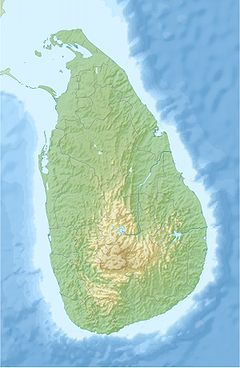- Navaly church bombing
-
Navaly church bombing Location Navaly, Sri Lanka Coordinates 9°43′N 79°59′E / 9.717°N 79.983°ECoordinates: 9°43′N 79°59′E / 9.717°N 79.983°E Date July 9, 1995 (+6 GMT) Target Sri Lankan Tamils Attack type Aerial bombardment Weapon(s) Bomb Death(s) 125 Injured Unknown but many Perpetrator(s) Sri Lankan Airforce The Navaly Church bombing was the bombing of The Church of Saint Peter and Saint Paul in Navaly or Navali in the Jaffna peninsula in Sri Lanka by the Sri Lankan Air Force. It is estimated that at least 125 civilians, who found refuge from the fighting inside the church, have died as a result of this incident. The victims included men, women and children[1][2]
Contents
Background information
This incident occurred during a phase of the conflict where the Sri Lankan military were on the offensive to retake the Jaffna peninsula. This operation was already highlighted by the use of intense artillery shelling and aerial bombardment.[3] As part of precautions to avoid civilian casualties the military had distributed leaflets requesting minority Sri Lankan Tamil civilians find shelter at places of worship. For their safety hundreds of civilians had taken refuge in the church[4]
Incident
The Church of St. Peter and Paul in Navaly (also spelled Navali) located on the Jaffna peninsula was bombed by a Sri Lankan military aircraft on the afternoon of July 9, 1995. Several hundred Tamil civilians were taking refuge at the church and surrounding environs at the time.
According to Daya Somasundaram, a professor of the University of Adelaide[5] the church was well away from the fighting. He termed this attack a War Crime committed by the Sri Lankan Air Force[2]
Initial reports
The news of the incident was first broken by the International Committee of the Red Cross, which at the time was the only aid agency working in the Tamil areas. The ICRC helped evacuate many of the wounded by ambulance to the Jaffna Teaching Hospital.
Immediate casualties were given as 65 killed and over 150 injured, many were women and children. Eventually this figure rose to a 125 killed, as many succumbed to their injuries.[1] This was partly due to the fact that the hospital was unable to cope with so many casualties at one time.[citation needed]
The aftermath
The Sri Lankan government initially denied any knowledge of the bombing, and then claimed it could have been LTTE mortars that caused the damage. The Commander of the Sri Lankan Air Force claimed they exploded LTTE ammunition trucks or underground ammunition storage and claimed that the deaths of the civilians were caused by secondary explosions of underground LTTE ammunition dumps.[6] However, in a later report, the ICRC head in Sri Lanka, Marco Altherr, stated that it was indeed bombs that had fallen on the area; he further included eyewitness accounts from civilians in the area, including a priest from another church in the vicinity that also supported this claim. Eventually the government agreed to investigate the incident.[3][7]
In the aftermath of this attack the Red Cross protested this attack. However, this protest was brought to a close after the members involved in the protest were summoned to the foreign office and was asked to give up the protest.[2]
Government investigation and results
On July 11, Sri Lankan President Chandrika Kumaratunge released a statement that expressed "sorrow at the loss of lives" and ordered the investigate of the bombing. On July 18, the military had confirmed that the church was badly damaged but said that they could not confirm the origin of the bombs that destroyed it.[4]
See also
- List of massacres in Sri Lanka
- List of attacks attributed to Sri Lankan government forces
- List of attacks attributed to the LTTE
References
- ^ a b 1995 Human Rights report – South Asia
- ^ a b c Somasundaram, D. (1997). "Abandoning jaffna hospital: Ethical and moral dilemmas". Medicine, Conflict and Survival 13 (4): 333–347. doi:10.1080/13623699708409357.
- ^ a b UTHR Bulletin # 17
- ^ a b 1995 HRW report – Sri Lanka
- ^ War more traumatic than tsunami
- ^ "SRI LANKA". Amnesty International. 1996-08-14. http://web.amnesty.org/library/Index/ENGASA370081996?open&of=ENG-LKA. Retrieved 2007-08-21.
- ^ ICRC Document
Categories:- Civilian massacres in Sri Lanka
- Human rights abuses in Sri Lanka
- History of Sri Lanka
- Sri Lankan Tamil history
- 1995 in Sri Lanka
- Aerial bombing in Sri Lanka
- Mass murder in 1995
- Sri Lanka Air Force
Wikimedia Foundation. 2010.

